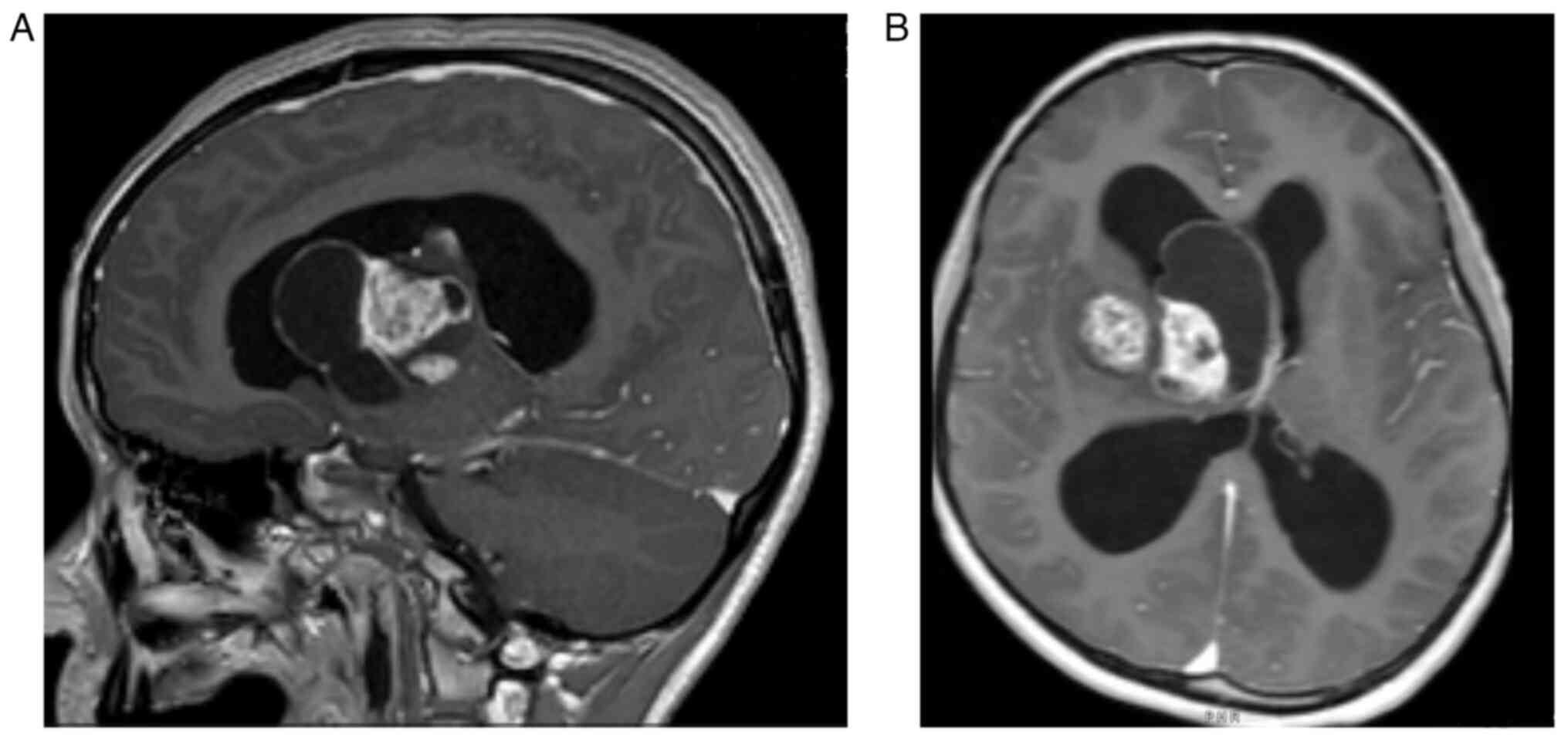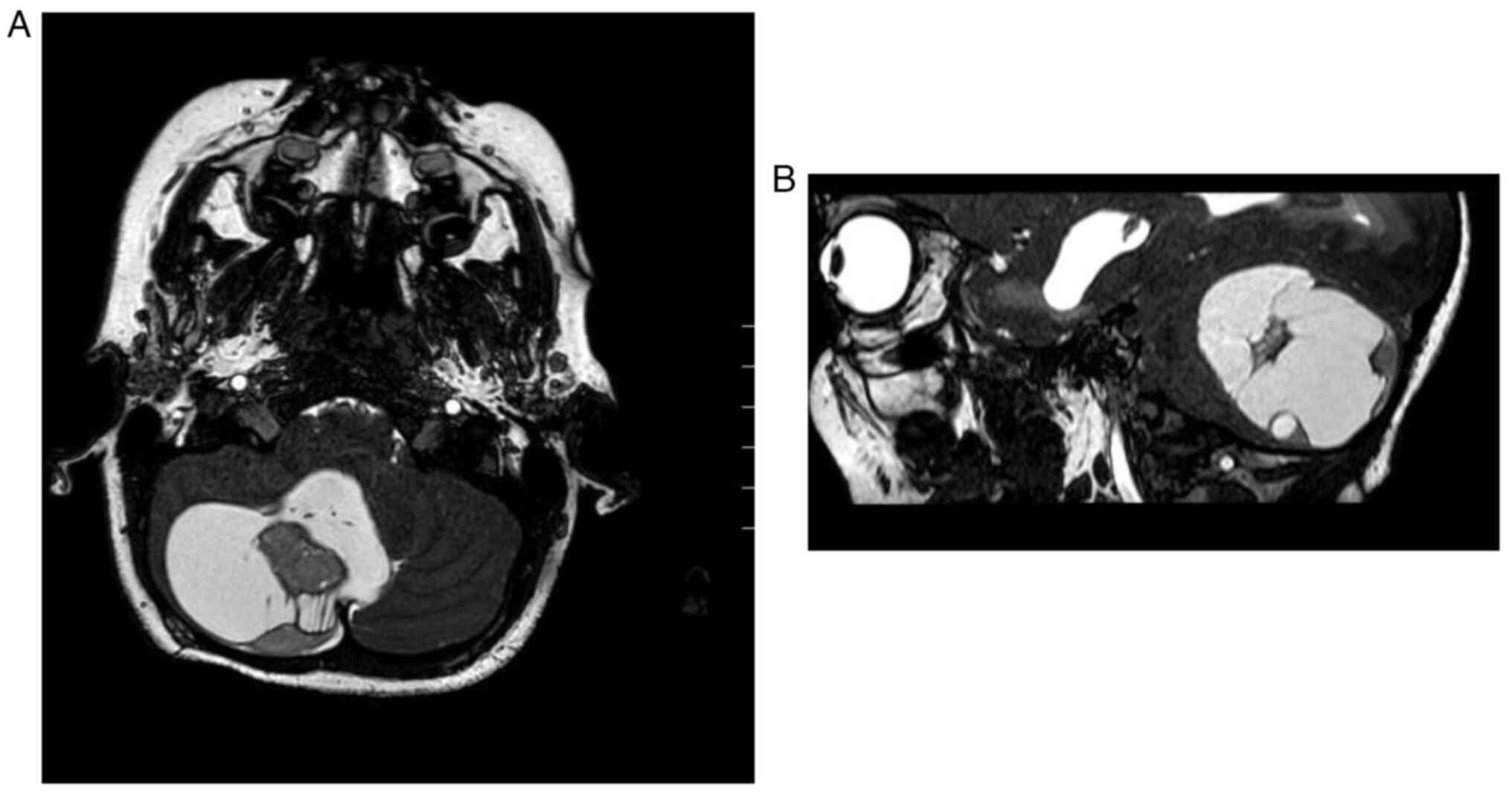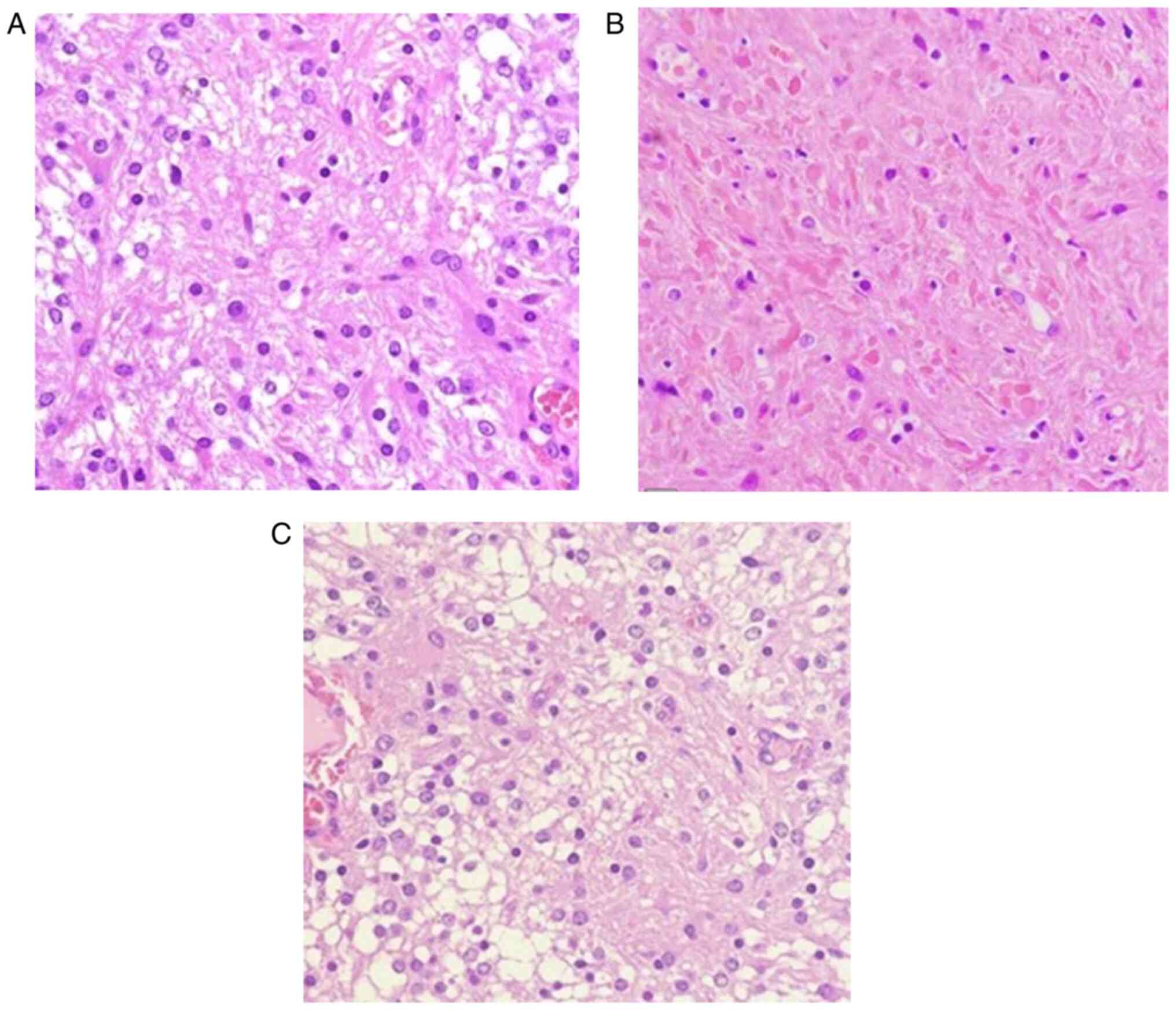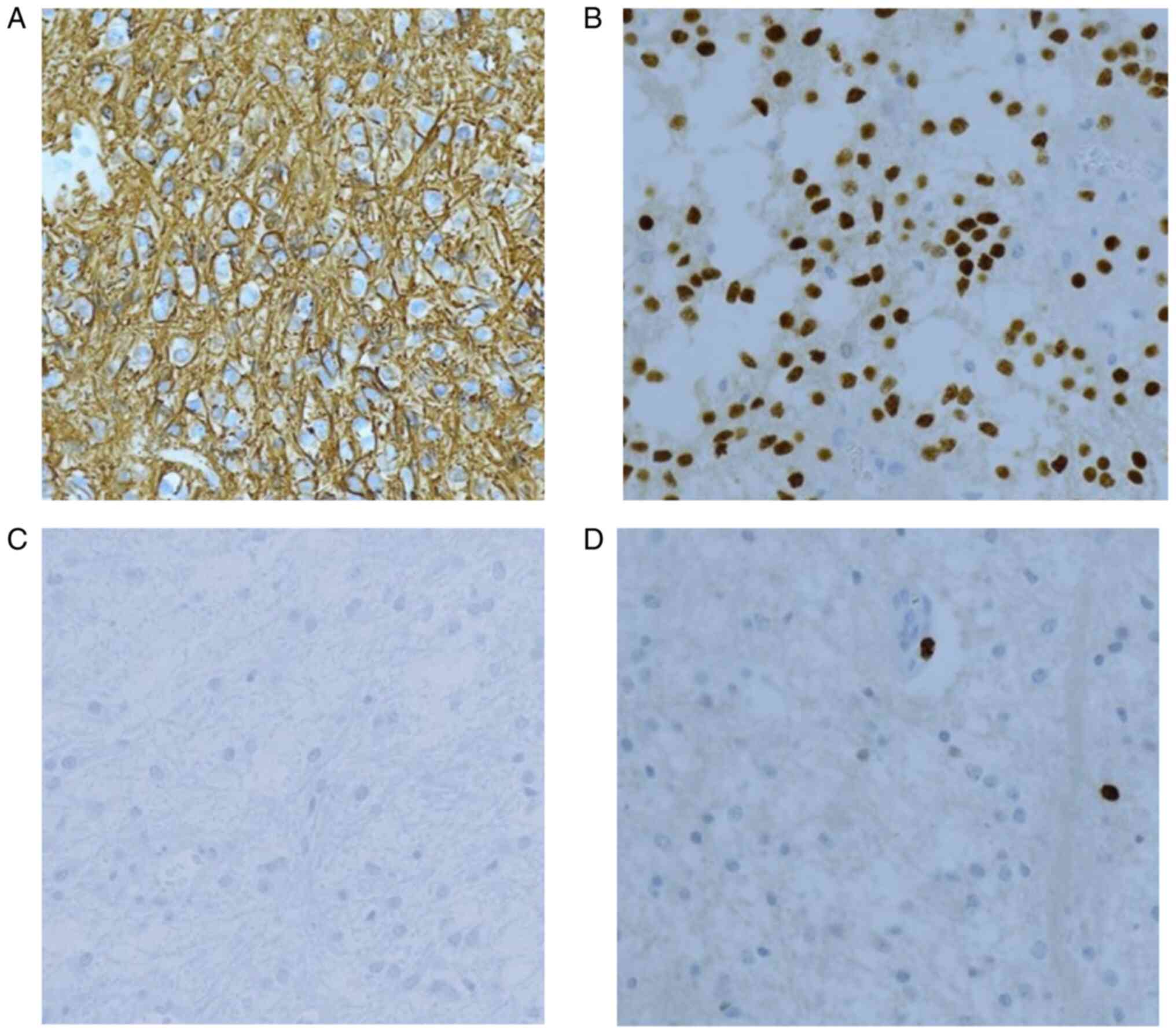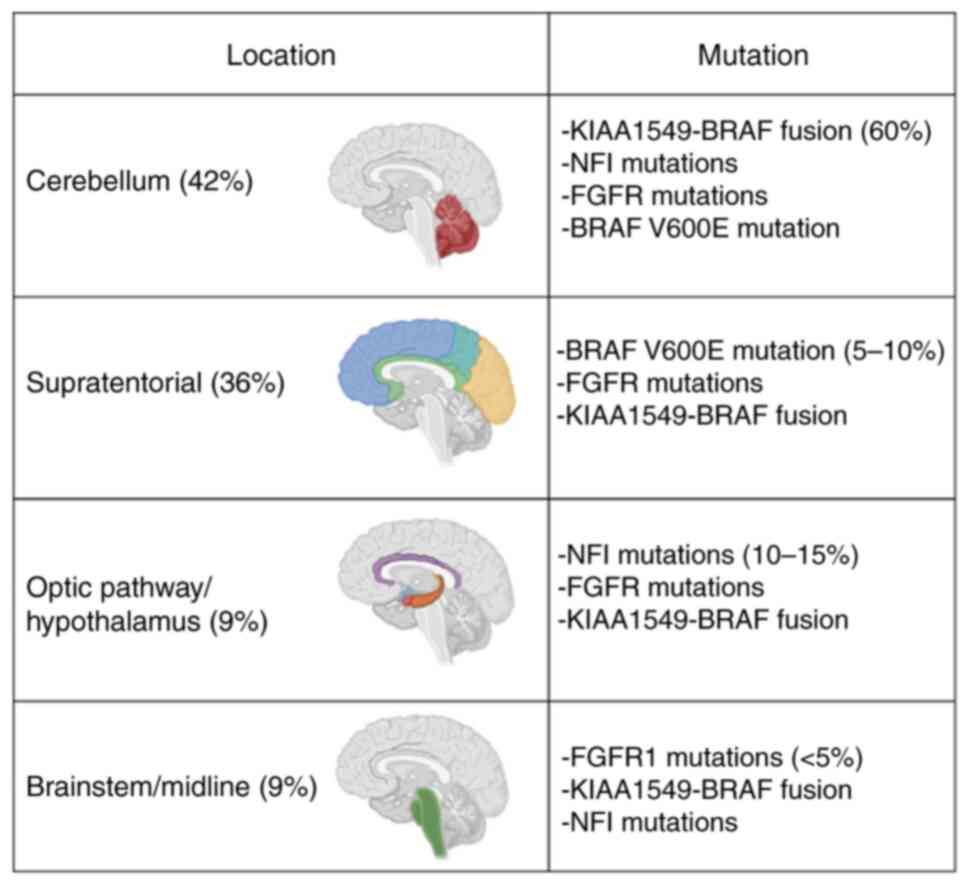|
1
|
Ius T, Cesselli D, Isola M, Pauletto G,
Tomasino B, D'Auria S, Bagatto D, Pegolo E, Beltrami AP, Loreto CD
and Skrap M: Incidental Low-Grade Gliomas: Single-Institution
management based on clinical, surgical, and molecular data.
Neurosurgery. 86:391–399. 2020. View Article : Google Scholar : PubMed/NCBI
|
|
2
|
Louis DN, Perry A, Wesseling P, Brat DJ,
Cree IA, Figarella-Branger D, Hawkins C, Ng HK, Pfister SM,
Reifenberger G, et al: The 2021 WHO classification of tumors of the
central nervous system: A summary. Neuro Oncol. 23:1231–1251. 2021.
View Article : Google Scholar : PubMed/NCBI
|
|
3
|
Collins VP, Jones DTW and Giannini C:
Pilocytic astrocytoma: Pathology, molecular mechanisms and markers.
Acta Neuropathol. 129:775–788. 2015. View Article : Google Scholar : PubMed/NCBI
|
|
4
|
Lodi M, Boccuto L, Carai A, Cacchione A,
Miele E, Colafati GS, Diomedi Camassei F, De Palma L, De Benedictis
A, Ferretti E, et al: Low-Grade gliomas in patients with noonan
syndrome: Case-Based review of the literature. Diagnostics (Basel).
10:5822020. View Article : Google Scholar : PubMed/NCBI
|
|
5
|
Gutmann DH, McLellan MD, Hussain I, Wallis
JW, Fulton LL, Fulton RS, Magrini V, Demeter R, Wylie T, Kandoth C,
et al: Somatic neurofibromatosis type 1 (NF1) inactivation
characterizes NF1-associated pilocytic astrocytoma. Genome Res.
23:431–439. 2013. View Article : Google Scholar : PubMed/NCBI
|
|
6
|
Valera ET, McConechy MK, Gayden T, Rivera
B, Jones DTW, Wittmann A, Han H, Bareke E, Nikbakht H, Mikael L, et
al: Methylome analysis and whole-exome sequencing reveal that brain
tumors associated with encephalocraniocutaneous lipomatosis are
midline pilocytic astrocytomas. Acta Neuropathol. 136:657–660.
2018. View Article : Google Scholar : PubMed/NCBI
|
|
7
|
Salles D, Laviola G, Malinverni ACM and
Stávale JN: Pilocytic Astrocytoma: A review of general, clinical,
and molecular characteristics. J Child Neurol. 35:852–858. 2020.
View Article : Google Scholar : PubMed/NCBI
|
|
8
|
Bell D, Chitnavis BP, Al-Sarraj S, Connor
S, Sharr MM and Gullan RW: Pilocytic astrocytoma of the
adult-clinical features, radiological features and management. Br J
Neurosurg. 18:613–616. 2004. View Article : Google Scholar : PubMed/NCBI
|
|
9
|
Ryu HH, Jung TY, Lee GJ, Lee KH, Jung SH,
Jung S and Baek HJ: Differences in the clinical courses of
pediatric and adult pilocytic astrocytomas with progression: A
single-institution study. Child's Nerv Syst. 31:2063–2069. 2015.
View Article : Google Scholar : PubMed/NCBI
|
|
10
|
Opancina V, Esposito S, Di Meco F, Bruno
E, Moscatelli M, Vetrano IG, Chiapparini L, Opancina M, Farinotti
M, Zdravkovic N, et al: Magnetic resonance imaging characteristics
of pediatric pilocytic astrocytoma. Neurol Sci. 44:4033–4040. 2023.
View Article : Google Scholar : PubMed/NCBI
|
|
11
|
Ajithkumar T, Taylor R and Kortmann RD:
Radiotherapy in the management of paediatric low-grade gliomas.
Clin Oncol (R Coll Radiol). 31:151–161. 2019. View Article : Google Scholar : PubMed/NCBI
|
|
12
|
Santino SF, Salles D, Stávale JN and
Malinverni ACM: Pathophysiological evaluation of pilocytic
astrocytoma in adults: Histopathological and immunohistochemical
analysis. Pathol Res Pract. 248:1545932023. View Article : Google Scholar : PubMed/NCBI
|
|
13
|
Griesinger AM, Birks DK, Donson AM, Amani
V, Hoffman LM, Waziri A, Wang M, Handler MH and Foreman NK:
Characterization of distinct immunophenotypes across pediatric
brain tumor types. J Immunol. 191:4880–4888. 2013. View Article : Google Scholar : PubMed/NCBI
|
|
14
|
Annovazzi L, Mellai M, Bovio E, Mazzetti
S, Pollo B and Schiffer D: Microglia immunophenotyping in gliomas.
Oncol Lett. 15:998–1006. 2018.PubMed/NCBI
|
|
15
|
Komotar RJ, Mocco J, Carson BS, Sughrue
ME, Zacharia BE, Sisti AC, Canoll PD, Khandji AG, Tihan T, Burger
PC and Bruce JN: Pilomyxoid astrocytoma: A review. MedGenMed.
6:422004.PubMed/NCBI
|
|
16
|
Lee IH, Kim JH, Suh YL, Eo H, Shin HJ, Yoo
SY and Lee KS: Imaging characteristics of pilomyxoid astrocytomas
in comparison with pilocytic astrocytomas. Eur J Radiol.
79:311–316. 2011. View Article : Google Scholar : PubMed/NCBI
|
|
17
|
Alkonyi B, Nowak J, Gnekow AK, Pietsch T
and Warmuth-Metz M: Differential imaging characteristics and
dissemination potential of pilomyxoid astrocytomas versus pilocytic
astrocytomas. Neuroradiology. 57:625–638. 2015. View Article : Google Scholar : PubMed/NCBI
|
|
18
|
Chaulagain D, Smolanka V and Smolanka A:
Pilocytic astrocytoma: A literature review. Int Neurol J. 18:39–45.
2022.
|
|
19
|
She D, Liu J, Zeng Z, Xing Z and Cao D:
Diagnostic accuracy of diffusion weighted imaging for
differentiation of supratentorial pilocytic astrocytoma and
pleomorphic xanthoastrocytoma. Neuroradiology. 60:725–733. 2018.
View Article : Google Scholar : PubMed/NCBI
|
|
20
|
Shaikh N, Brahmbhatt N, Kruser TJ, Kam KL,
Appin CL, Wadhwani N, Chandler J, Kumthekar P and Lukas RV:
Pleomorphic xanthoastrocytoma: A brief review. CNS Oncol.
8:CNS392019. View Article : Google Scholar : PubMed/NCBI
|
|
21
|
Rahim S, Ud Din N, Abdul-Ghafar J,
Chundriger Q, Khan P and Ahmad Z: Clinicopathological features of
dysembryoplastic neuroepithelial tumor: A case series. J Med Case
Rep. 17:3272023. View Article : Google Scholar : PubMed/NCBI
|
|
22
|
Salles D, Santino SF, Ribeiro DA,
Malinverni ACM and Stávale JN: The involvement of the MAPK pathway
in pilocytic astrocytomas. Pathol Res Pract. 232:1538212022.
View Article : Google Scholar : PubMed/NCBI
|
|
23
|
Cler SJ, Skidmore A, Yahanda AT, Mackey K,
Rubin JB, Cluster A, Perkins S, Gauvain K, King AA, Limbrick DD, et
al: Genetic and histopathological associations with outcome in
pediatric pilocytic astrocytoma. J Neurosurg Pediatr. 29:504–512.
2022. View Article : Google Scholar : PubMed/NCBI
|
|
24
|
Jones TA, Jeyapalan JN, Forshew T,
Tatevossian RG, Lawson AR, Patel SN, Doctor GT, Mumin MA, Picker
SR, Phipps KP, et al: Molecular analysis of pediatric brain tumors
identifies microRNAs in pilocytic astrocytomas that target the MAPK
and NF-κB pathways. Acta Neuropathol Commun. 3:862015. View Article : Google Scholar : PubMed/NCBI
|
|
25
|
Rodriguez FJ, Schniederjan MJ, Nicolaides
T, Tihan T, Burger PC and Perry A: High rate of concurrent
BRAF-KIAA1549 gene fusion and 1p deletion in disseminated
oligodendroglioma-like leptomeningeal neoplasms (DOLN). Acta
Neuropathol. 129:609–610. 2015. View Article : Google Scholar : PubMed/NCBI
|
|
26
|
Kumar A, Pathak P, Purkait S, Faruq M, Jha
P, Mallick S, Suri V, Sharma MC, Suri A and Sarkar C: Oncogenic
KIAA1549-BRAF fusion with activation of the MAPK/ERK pathway in
pediatric oligodendrogliomas. Cancer Genet. 208:91–95. 2015.
View Article : Google Scholar : PubMed/NCBI
|
|
27
|
Roth JJ, Santi M, Pollock AN, Harding BN,
Rorke-Adams LB, Tooke LS and Biegel JA: Chromosome Band 7q34
Deletions Resulting in KIAA 1549-BRAF and FAM 131 B-BRAF fusions in
pediatric low-grade gliomas. Brain Pathol. 25:182–192. 2015.
View Article : Google Scholar : PubMed/NCBI
|
|
28
|
Ryall S, Arnoldo A, Krishnatry R, Mistry
M, Khor K, Sheth J, Ling C, Leung S, Zapotocky M, Guerreiro
Stucklin A, et al: Multiplex detection of pediatric low-grade
glioma signature fusion transcripts and duplications using the
NanoString nCounter system. J Neuropathol Exp Neurol. 76:562–570.
2017. View Article : Google Scholar : PubMed/NCBI
|
|
29
|
Gregory TA, Chumbley LB, Henson JW and
Theeler BJ: Adult pilocytic astrocytoma in the molecular era: A
comprehensive review. CNS Oncol. 10:CNS682021. View Article : Google Scholar : PubMed/NCBI
|
|
30
|
Lin R, Kenyon A, Wang ZX, Cai J, Iacovitti
L and Kenyon LC: Pilocytic astrocytoma harboring a novel GNAI3-BRAF
fusion. Neuropathology. 43:391–395. 2023. View Article : Google Scholar : PubMed/NCBI
|
|
31
|
Laviv Y, Toledano H, Michowiz S,
Dratviman-Storobinsky O, Turm Y, Fichman-Horn S, Kagnovski E and
Goldenberg-Cohen N: BRAF, GNAQ, and GNA11 mutations and copy number
in pediatric low-grade glioma. FEBS Open Bio. 2:129–134. 2012.
View Article : Google Scholar : PubMed/NCBI
|
|
32
|
Zwaig M, Baguette A, Hu B, Johnston M,
Lakkis H, Nakada EM, Faury D, Juretic N, Ellezam B, Weil AG, et al:
Detection and genomic analysis of BRAF fusions in Juvenile
Pilocytic Astrocytoma through the combination and integration of
multi-omic data. BMC Cancer. 22:12972022. View Article : Google Scholar : PubMed/NCBI
|
|
33
|
Tomić TT, Olausson J, Wilzén A, Sabel M,
Truvé K, Sjögren H, Dósa S, Tisell M, Lannering B, Enlund F, et al:
A new GTF2I-BRAF fusion mediating MAPK pathway activation in
pilocytic astrocytoma. PLoS One. 12:e01756382017. View Article : Google Scholar : PubMed/NCBI
|
|
34
|
Rodriguez EF, Scheithauer BW, Giannini C,
Rynearson A, Cen L, Hoesley B, Gilmer-Flynn H, Sarkaria JN, Jenkins
S, Long J and Rodriguez FJ: PI3K/AKT pathway alterations are
associated with clinically aggressive and histologically anaplastic
subsets of pilocytic astrocytoma. Acta Neuropathol. 121:407–420.
2011. View Article : Google Scholar : PubMed/NCBI
|
|
35
|
Engelhardt S, Behling F, Beschorner R,
Eckert F, Kohlhof P, Tatagiba M, Tabatabai G, Schuhmann MU, Ebinger
M and Schittenhelm J: Frequent FGFR1 hotspot alterations in
driver-unknown low-grade glioma and mixed neuronal-glial tumors. J
Cancer Res Clin Oncol. 148:857–866. 2022. View Article : Google Scholar : PubMed/NCBI
|
|
36
|
Jones DT, Hutter B, Jäger N, Korshunov A,
Kool M, Warnatz HJ, Zichner T, Lambert SR, Ryzhova M, Quang DA, et
al: Recurrent somatic alterations of FGFR1 and NTRK2 in pilocytic
astrocytoma. Nat Genet. 45:927–932. 2013. View Article : Google Scholar : PubMed/NCBI
|
|
37
|
Asuzu DT, Desai B, Maggio D, Mandell J,
Ray-Chaudhury A, Abdullaev Z, Aldape K, Heiss J and Buchholz AL:
FGFR1-TACC1 fusion associated with malignant transformation in a
primary spinal cord glioma: A case report. J Spine Surg. 7:434–438.
2021. View Article : Google Scholar : PubMed/NCBI
|
|
38
|
Rivera B, Gayden T, Carrot-Zhang J, Nadaf
J, Boshari T, Faury D, Zeinieh M, Blanc R, Burk DL, Fahiminiya S,
et al: Germline and somatic FGFR1 abnormalities in dysembryoplastic
neuroepithelial tumors. Acta Neuropathol. 131:847–863. 2016.
View Article : Google Scholar : PubMed/NCBI
|
|
39
|
Trisolini E, Wardighi DE, Giry M, Bernardi
P, Boldorini RL, Mokhtari K and Sanson M: Actionable FGFR1 and BRAF
mutations in adult circumscribed gliomas. J Neurooncol.
145:241–245. 2019. View Article : Google Scholar : PubMed/NCBI
|
|
40
|
Jones DT, Kocialkowski S, Liu L, Pearson
DM, Ichimura K and Collins VP: Oncogenic RAF1 rearrangement and a
novel BRAF mutation as alternatives to KIAA1549:BRAF fusion in
activating the MAPK pathway in pilocytic astrocytoma. Oncogene.
28:2119–2123. 2009. View Article : Google Scholar : PubMed/NCBI
|
|
41
|
Yde CW, Sehested A, Mateu-Regué À, Østrup
O, Scheie D, Nysom K, Nielsen FC and Rossing M: A new NFIA:RAF1
fusion activating the MAPK pathway in pilocytic astrocytoma. Cancer
Genet. 209:440–444. 2016. View Article : Google Scholar : PubMed/NCBI
|
|
42
|
Janzarik WG, Kratz CP, Loges NT, Olbrich
H, Klein C, Schäfer T, Scheurlen W, Roggendorf W, Weiller C,
Niemeyer C, et al: Further Evidence for a Somatic KRAS Mutation in
a Pilocytic Astrocytoma. Neuropediatrics. 38:61–63. 2007.
View Article : Google Scholar : PubMed/NCBI
|
|
43
|
Guerreiro Stucklin AS, Ryall S, Fukuoka K,
Zapotocky M, Lassaletta A, Li C, Bridge T, Kim B, Arnoldo A,
Kowalski PE, et al: Alterations in ALK/ROS1/NTRK/MET drive a group
of infantile hemispheric gliomas. Nat Commun. 10:43432019.
View Article : Google Scholar : PubMed/NCBI
|
|
44
|
Orillac C, Thomas C, Dastagirzada Y,
Hidalgo ET, Golfinos JG, Zagzag D, Wisoff JH, Karajannis MA and
Snuderl M: Pilocytic astrocytoma and glioneuronal tumor with
histone H3 K27M mutation. Acta Neuropathol Commun. 4:842016.
View Article : Google Scholar : PubMed/NCBI
|
|
45
|
Morita S, Nitta M, Muragaki Y, Komori T,
Masui K, Maruyama T, Ichimura K, Nakano Y, Sawada T, Koriyama S, et
al: Brainstem pilocytic astrocytoma with H3 K27M mutation: Case
report. J Neurosurg. 129:593–597. 2018. View Article : Google Scholar : PubMed/NCBI
|
|
46
|
AlShail E, Alahmari AN, Dababo AAM,
Alsagob M, Al-Hindi H, Khalil H, Al Masseri Z, AlSalamah R,
Almohseny E, Alduhaish A, et al: A molecular study of pediatric
pilomyxoid and pilocytic astrocytomas: Genome-wide copy number
screening, retrospective analysis of clinicopathological features
and long-term clinical outcome. Front Oncol. 13:10342922023.
View Article : Google Scholar : PubMed/NCBI
|
|
47
|
Reinhardt A, Stichel D, Schrimpf D, Sahm
F, Korshunov A, Reuss DE, Koelsche C, Huang K, Wefers AK, Hovestadt
V, et al: Anaplastic astrocytoma with piloid features, a novel
molecular class of IDH wildtype glioma with recurrent MAPK pathway,
CDKN2A/B and ATRX alterations. Acta Neuropathol. 136:273–291. 2018.
View Article : Google Scholar : PubMed/NCBI
|
|
48
|
Konar SK, Shukla D, Nandeesh BN, Prabhuraj
AR and Devi BI: Surgical management and outcome of a bilateral
thalamic pilocytic astrocytoma: Case report and review of the
literature. Pediatr Neurosurg. 54:139–142. 2019. View Article : Google Scholar : PubMed/NCBI
|
|
49
|
Onorini N, Spennato P, Orlando V, Savoia
F, Calì C, Russo C, De Martino L, de Santi MS, Mirone G, Ruggiero
C, et al: The clinical and prognostic impact of the choice of
surgical approach to fourth ventricular tumors in a single-center,
single-surgeon cohort of 92 consecutive pediatric patients. Front
Oncol. 12:8217382022. View Article : Google Scholar : PubMed/NCBI
|
|
50
|
Sager O, Dincoglan F, Demiral S, Uysal B,
Gamsiz H, Gumustepe E, Ozcan F, Colak O, Gursoy AT, Dursun CU, et
al: Concise review of radiosurgery for contemporary management of
pilocytic astrocytomas in children and adults. World J Exp Med.
12:36–43. 2022. View Article : Google Scholar : PubMed/NCBI
|
|
51
|
Becker AP, Scapulatempo-Neto C, Carloni
AC, Paulino A, Sheren J, Aisner DL, Musselwhite E, Clara C, Machado
HR, Oliveira RS, et al: KIAA1549: BRAF Gene Fusion and FGFR1
Hotspot Mutations Are Prognostic Factors in Pilocytic Astrocytomas.
J Neuropathol Exp Neurol. 74:743–754. 2015. View Article : Google Scholar : PubMed/NCBI
|
|
52
|
Hawkins C, Walker E, Mohamed N, Zhang C,
Jacob K, Shirinian M, Alon N, Kahn D, Fried I, Scheinemann K, et
al: BRAF-KIAA1549 fusion predicts better clinical outcome in
pediatric low-grade astrocytoma. Clin Cancer Res. 17:4790–4798.
2011. View Article : Google Scholar : PubMed/NCBI
|
|
53
|
Liu H, Chen Y, Qin X, Jin Z, Jiang Y and
Wang Y: Epidemiology and survival of patients with optic pathway
gliomas: A population-based analysis. Front Oncol. 12:7898562022.
View Article : Google Scholar : PubMed/NCBI
|
|
54
|
Manoharan N, Liu KX, Mueller S, Haas-Kogan
DA and Bandopadhayay P: Pediatric low-grade glioma: Targeted
therapeutics and clinical trials in the molecular era. Neoplasia.
36:1008572023. View Article : Google Scholar : PubMed/NCBI
|
|
55
|
Lassaletta A, Scheinemann K, Zelcer SM,
Hukin J, Wilson BA, Jabado N, Carret AS, Lafay-Cousin L, Larouche
V, Hawkins CE, et al: Phase II weekly vinblastine for
chemotherapy-naïve children with progressive low-grade glioma: A
canadian pediatric brain tumor consortium study. J Clin Oncol.
34:3537–3543. 2016. View Article : Google Scholar : PubMed/NCBI
|
|
56
|
Fangusaro J, Onar-Thomas A, Poussaint TY,
Wu S, Ligon AH, Lindeman N, Campagne O, Banerjee A, Gururangan S,
Kilburn LB, et al: A phase II trial of selumetinib in children with
recurrent optic pathway and hypothalamic low-grade glioma without
NF1: A Pediatric Brain Tumor Consortium study. Neuro Oncol.
23:1777–1788. 2021. View Article : Google Scholar : PubMed/NCBI
|
|
57
|
Fangusaro J, Onar-Thomas A, Young
Poussaint T, Wu S, Ligon AH, Lindeman N, Banerjee A, Packer RJ,
Kilburn LB, Goldman S, et al: Selumetinib in paediatric patients
with BRAF-aberrant or neurofibromatosis type 1-associated
recurrent, refractory, or progressive low-grade glioma: A
multicentre, phase 2 trial. Lancet Oncol. 20:1011–1022. 2019.
View Article : Google Scholar : PubMed/NCBI
|
|
58
|
Wen PY, Stein A, van den Bent M, De Greve
J, Wick A, de Vos FYFL, von Bubnoff N, van Linde ME, Lai A, Prager
GW, et al: Dabrafenib plus trametinib in patients with
BRAFV600E-mutant low-grade and high-grade glioma (ROAR): A
multicentre, open-label, single-arm, phase 2, basket trial. Lancet
Oncol. 23:53–64. 2022. View Article : Google Scholar : PubMed/NCBI
|
|
59
|
Bouffet E, Hansford J, Garré ML, Hara J,
Plant-Fox A, Aerts I, Locatelli F, Van der Lugt J, Papusha L, Sahm
F, et al: Primary analysis of a phase II trial of dabrafenib plus
trametinib (dab + tram) in BRAF V600-mutant pediatric low-grade
glioma (pLGG). J Clin Oncol. 40:LBA20022022. View Article : Google Scholar
|
|
60
|
Wright KD, Yao X, London WB, Kao PC, Gore
L, Hunger S, Geyer R, Cohen KJ, Allen JC, Katzenstein HM, et al: A
POETIC Phase II study of continuous oral everolimus in recurrent,
radiographically progressive pediatric low-grade glioma. Pediatr
Blood Cancer. 68:e287872021. View Article : Google Scholar : PubMed/NCBI
|
|
61
|
Theeler BJ, Ellezam B, Yust-Katz S, Slopis
JM, Loghin ME and de Groot JF: Prolonged survival in adult
neurofibromatosis type I patients with recurrent high-grade gliomas
treated with bevacizumab. J Neurol. 261:1559–1564. 2014. View Article : Google Scholar : PubMed/NCBI
|
|
62
|
Wasilewski A and Mohile N: Durable
response to bevacizumab in adults with recurrent pilocytic
astrocytoma. CNS Oncol. 7:CNS262018. View Article : Google Scholar : PubMed/NCBI
|
|
63
|
Kaur A, Doberstein T, Amberker RR, Garje
R, Field EH and Singh N: Immune-related adverse events in cancer
patients treated with immune checkpoint inhibitors. Medicine
(Baltimore). 98:e173482019. View Article : Google Scholar : PubMed/NCBI
|
|
64
|
Guo X, Pan Y, Xiong M, Sanapala S,
Anastasaki C, Cobb O, Dahiya S and Gutmann DH: Midkine activation
of CD8+ T cells establishes a neuron-immune-cancer axis responsible
for low-grade glioma growth. Nat Commun. 11:21772020. View Article : Google Scholar : PubMed/NCBI
|
|
65
|
Chen J, Sinha N, Cobb O, Liu C, Ersen A,
Phillips JJ, Tihan T, Gutmann DH and Dahiya S: Immune cell analysis
of pilocytic astrocytomas reveals sexually dimorphic brain
region-specific differences in T-cell content. Neurooncol Adv.
3:vdab0682021.PubMed/NCBI
|















